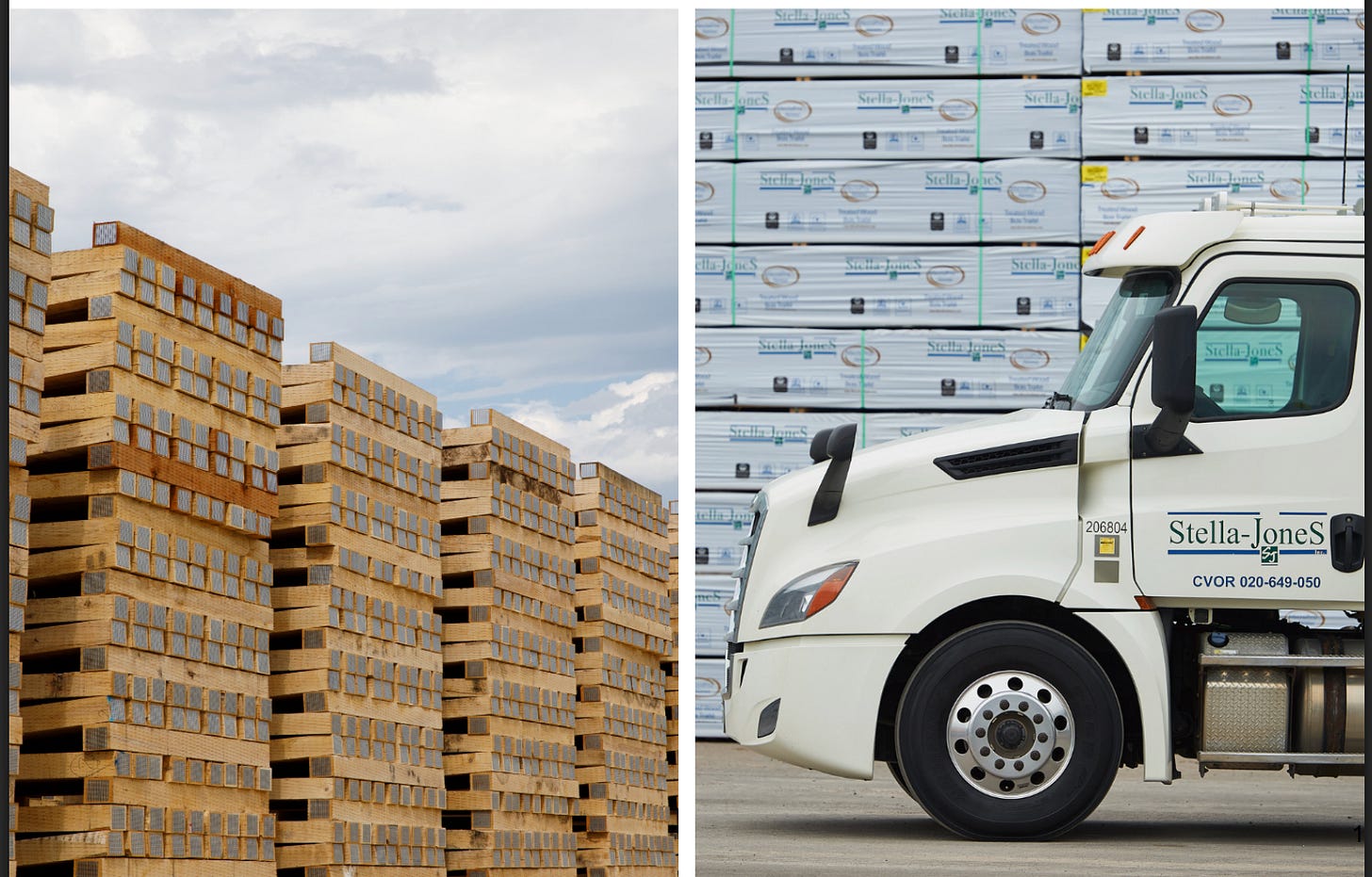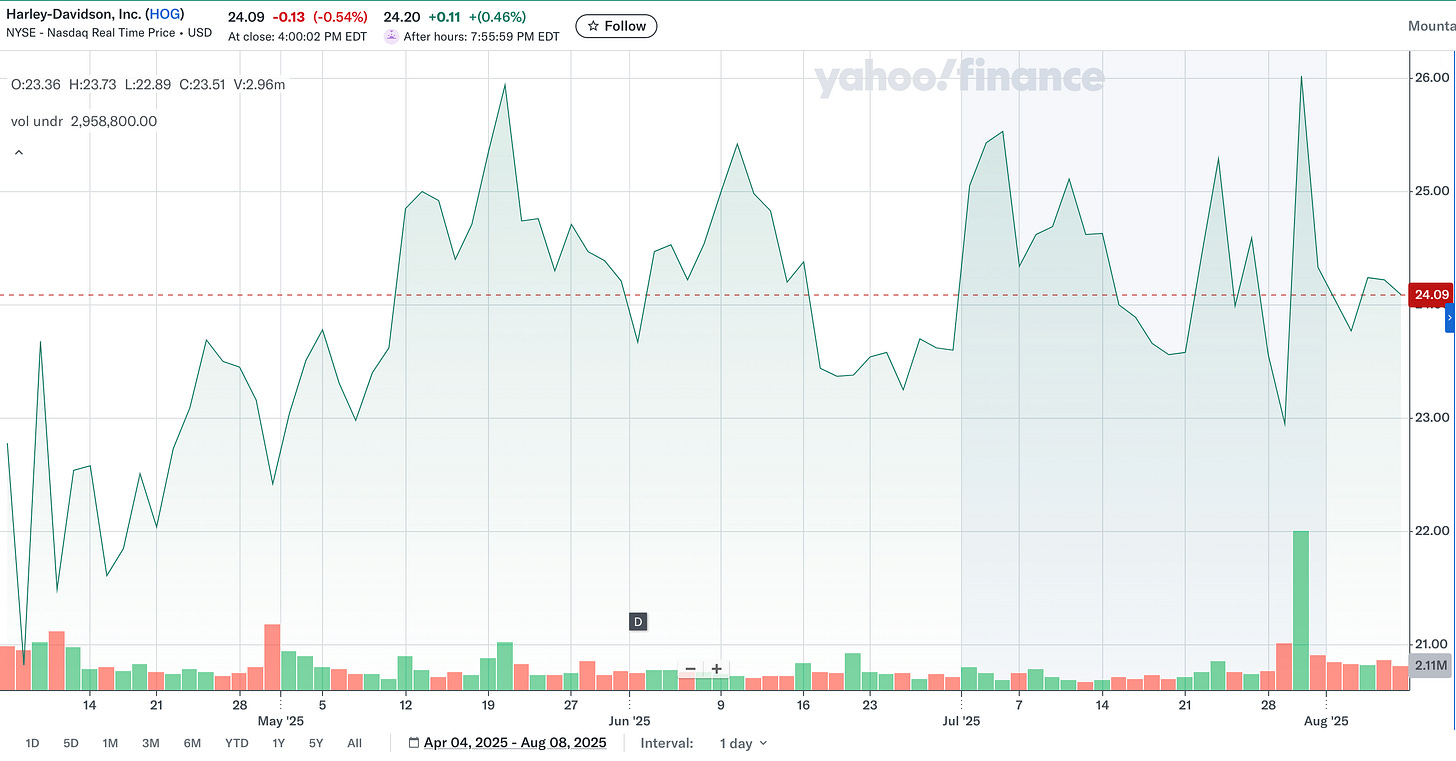Earnings Check-In: Stella-Jones Steadies On, Harley-Davidson Hits a Bump
A tale of two capital allocators - one compounding quietly, the other navigating a messy transition.
Quick updates on earnings results from two companies in my portfolio.
📘 Stella-Jones: FCF, Dividends, Buybacks - strong delivery
I wrote about Stella-Jones (TSE:SJ) earlier this year, and they just reported Q2 2025 results. On the surface, it was a slightly soft quarter - EPS came in at $1.91, compared to $1.94 a year ago, with sales also dipping slightly to $1.034B from $1.049B. But when you zoom out, the broader picture looks encouraging.
For the first half of the year, EPS is up meaningfully - $3.58 vs. $3.30 a year ago -showing that the company has recovered well from a slower Q1.
Inventories are down about 10% year-over-year, and buybacks have picked up pace: 215K shares were repurchased in Q1 and that ramped up to 489K in Q2. Long-term debt is down about 5% year-over-year, and most other balance sheet metrics - cash, retained earnings - are trending positively.
Free cash flow has also seen a strong improvement: around $150M for H1 2025 vs. $115M in the same period last year. The company continues to maintain a healthy dividend, which is on track for $1.24/share this year - representing a conservative ~20% payout ratio.
While I would have preferred stronger top-line growth, especially given infrastructure tailwinds, this was a solid quarter. If this trajectory continues, we could be at an interesting inflection point over the next 12–18 months.
The stock has been edging up through the year but dropped ~5% on the Q2 print, suggesting the market was hoping for more. That said, since my last post, the stock is up ~10%, plus ~1% in dividends. I continue to expect the company to earn just under $7/share this year, implying an ~11x P/E at today’s prices - which looks attractive for a quality compounder. I don’t plan to do nothing much except to add to the position when I have cash handy.
🏍️ Harley-Davidson: Q2 Misfires for Harley, But Capital Story Isn't Over Yet
On to Harley-Davidson (which I wrote about [here], [here], and [here]), which just reported a mixed bag of Q2 results.
The earnings story was weak. The company reported EPS of $0.88, with global sales down 15% year-over-year. On top of that, a $13M tariff-related charge hit the bottom line—roughly 12–13% of quarterly profits. So it’s getting squeezed both on revenue and cost sides.
On a first-half basis, results are slightly better, with EPS of $1.95, but still clearly trending below where bulls would want it. One positive: the company is making progress on reducing dealer inventory—down 28% YoY—which may help reset the channel over time.
Beyond the numbers, it was a dramatic quarter on the governance front. Harley successfully fended off a board challenge from H Partners, and made a partial move to exit its financing arm, HDFS, and appointed Artie Starrs as new CEO. Having failed to sell HDFS outright, the company struck a middle-path deal: it sold a minority stake to private equity (KKR and PIMCO) and will outsource new loan originations to them.
This frees up capital—roughly $1B net cash, based on a $5B asset sale vs. $4B in debt repayment—but it also means lower recurring earnings. Passing on loan originations sacrifices both interest rate spread and full ownership economics. Management expects HDFS earnings to fall from $250M to ~$100M annually, maybe even lower.
Putting it all together, Harley could settle into $300M–$350M in annual earnings, implying a ~10x P/E at current prices—assuming no growth.
I wouldn’t call the HDFS deal a slam-dunk win. Strategically, it's sensible, but the economics are mixed. What’s more disappointing is that the company repurchased zero shares in Q2, after buying back $87M worth in Q1. That’s a blow to my thesis, which was built on strong cash flows being used to steadily reduce share count—making remaining shares more valuable. The silver lining is that $500M of the HDFS proceeds have been earmarked for buybacks, but without a timeline.
If they follow through, we could see a ~15% share count reduction, assuming an average repurchase price of $30/share (vs. today’s ~$24). That would be meaningful.
My thesis was never about near-term earnings strength—it was about balance sheet health and disciplined capital allocation. While the balance sheet has improved modestly, capital deployment this quarter fell short. I’m not happy, but not throwing in the towel either. I’ll give it another quarter or two to see if management follows through on the buyback commitment.
The only consolation? The stock trades slightly above my entry price, suggesting I may have entered near a pessimism trough. Here’s hoping the next leg of the story is more rewarding.
On that note, Happy Investing!!
Disclaimer: I am not your financial advisor and bear no fiduciary responsibility. This post is only for educational and entertainment purposes. Do your own due diligence before investing in any securities. I may hold or enter into, a position in any of the stocks mentioned above. The above is NOT a solicitation to either buy or sell the securities listed in this post.




